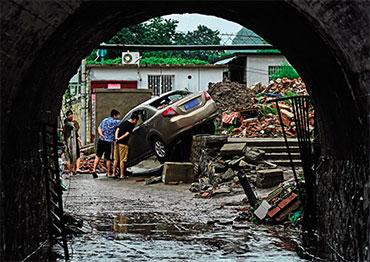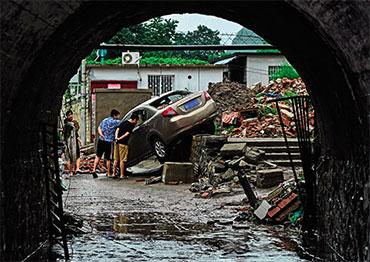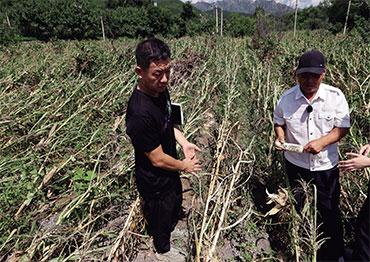Zhang Xin, a manager at a major Chinese insurer, told NewsChina that most of the recent claims they received for vehicle damage involved flooding. Public data shows that as of August 8, insurance companies in Hebei, Beijing, Heilongjiang, Jilin and Tianjin had received at least 70,500 auto insurance claims, far exceeding claims for property damage and agricultural insurance, for estimated losses of 1.47 billion yuan (US$200.6m).
Since 2020, auto insurance in China covers damage from natural disasters such as rainstorms, typhoons and floods. In most cases, policyholders can file claims if their car’s engine or battery suffers water damage.
Agricultural insurance claims also spiked after the floods in July and August, the harvest season for many crops. Rains from Typhoon Doksuri slammed Wuchang in Heilongjiang Province, a major rice producer, leaving large swathes of paddies inundated.
Wang Shouxin, director of Wuchang Agriculture and Rural Affairs Bureau, told NewsChina that 66,667 of the city’s 168,667 hectares of rice paddies had been affected by Typhoon Doksuri to varying degrees.
A Wuchang rice farmer said he did all he could to save his crop from the August floods, such as clearing out collected sediment and spraying fertilizers. He estimated losses of around 150,000 yuan (US$204,667) on his family’s 40 mu (0.07 hectares) plot. Fortunately, he had agricultural insurance. “It won’t cover all my losses, but it’s better than nothing,” the farmer told NewsChina.
However, many others did not take that precaution. This was especially apparent among farmers in China’s northeast, where flooding is rare. “We never encountered such huge floods before, and never expected the paddies would get that flooded, so we didn’t buy insurance,” a farmer told NewsChina.
According to current rates, farmers paying a 5 yuan (US$0.68) premium are eligible for 376 yuan (US$51.3) in compensation per mu (0.0667 hectares) if floods damage their rice crops before the heading stage, or when buds are visible at the end of a rice stem. Those paying a 14-yuan (US$1.91) per mu can get 1,124 yuan (US$153.4) if their rice reached the heading period. On average, rice paddies yield 1,000 to 2,000 yuan (US$136.4 to 272.9) per mu.
According to data from Wuchang Agriculture and Rural Affairs Bureau, the city’s farmland covered by insurance amounts to 3.27 million mu (220,000 hectares), accounting for about 70 percent of its total arable land.
There are two types of agricultural insurance in China: “full-cost” and “income.” Subsidized by the central and local governments, the former covers costs for seeds, fertilizers, land and labor, and losses from natural disasters. The latter covers losses caused by price and output fluctuations.
Zhang Xin said full-cost insurance dominates the market due to its lower premiums. Income insurance policies are much more complex and expensive, thus less attractive to cash-strapped farmers. But without income insurance, farmers can only partially mitigate their losses from natural disasters.
As extreme weather events increase due to climate change, more people are seeking comprehensive policies beyond auto and agriculture, such as home and business insurance, Zhang Xin said.
Home insurance in China generally covers damage from natural disasters with the exception of earthquakes, which requires a separate policy. Enterprises can also buy insurance that covers property, equipment and raw materials.
But not all business properties are eligible, Zhang Xin said. During the devastating floods that submerged the city of Zhuozhou in Hebei Province in August, many booksellers were left ruined as there was no commercially available insurance policy for their warehouses.
According to Huang Ping, general manager of BooksChina.com, an online bookseller that lost large portions of its stock to the Zhuozhou floods, the company previously had insurance for its warehouses. However, their insurer stopped offering the policy. “We weren’t able to buy any comparable insurance for the last two years,” Huang said.
Huang’s situation is common. Most insurance companies in China do not offer policies to cover books, not only because they are vulnerable to water damage but also are easily outdated, making them a liability. The rare companies that do have very high premiums.
“If books get wet, they can’t be sold anymore, so insurance companies are very cautious and rarely offer insurance for products like books,” Zhang Xin said.

 Old Version
Old Version

